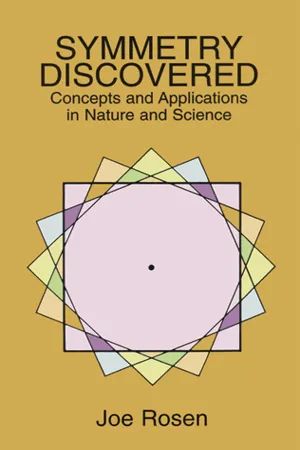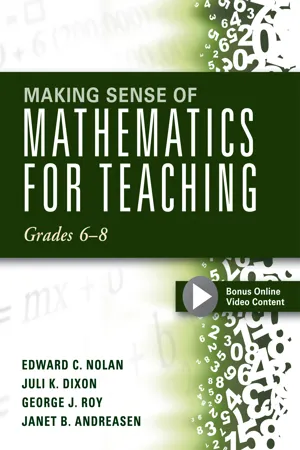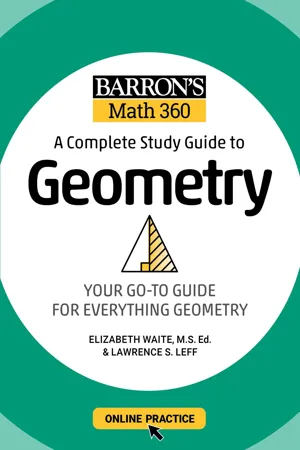Mathematics
Reflection in Geometry
Reflection in geometry is a transformation that flips a figure over a line, known as the line of reflection. The original figure and its reflection are mirror images of each other, with the same size and shape. This concept is fundamental in understanding symmetry and congruence in geometric shapes and patterns.
Written by Perlego with AI-assistance
Related key terms
Related key terms
1 of 4
Related key terms
1 of 3
3 Key excerpts on "Reflection in Geometry"
- eBook - ePub
Symmetry Discovered
Concepts and Applications in Nature and Science
- Joe Rosen(Author)
- 2012(Publication Date)
- Dover Publications(Publisher)
The intersection of the line and the plane is called the reflection center. The image of a point is therefore located in the plane of the system, directly opposite the initial point with respect to the reflection center, and at the same distance from the reflection center as is the initial point (fig. 3.21). Reflection transformations through different reflection centers do not commute. We do not devote further discussion to this transformation, because it is not really new; a line reflection transformation is completely equivalent to rotation by 180° about the reflection center. Fig. 3.21 Line reflection transformation of 2-dimensional system PROBLEM Convince yourself of this fact. Spatial symmetry Pooh looked at his two paws. He knew that one of them was the right, and he knew that when you had decided which one of them was the right, then the other one was the left, but he never could remember how to begin. (A.A. Milne: The House at Pooh Corner) All the geometric transformations that we considered for 2-dimensional systems are readily applied to 3-dimensional systems. These transformations are displacement, plane and line reflection, glide and rotation. As expected, the addition of a third dimension allows the application of transformations that are inapplicable to lower-dimensional systems. Of these we discuss point reflection and the screw. We also consider the dilation transformation, applicable to systems of any number of dimensions. The action of the displacement transformation on 3-dimensional systems is the obvious generalization of its action on 2-dimensional systems; there is one more dimension to displace into (fig. 3.22). As in the 2-dimensional case, all displacement transformations commute, whether or not they are in the same direction. Fig. 3.22 Some possible displacement transformations for 3-dimensional systems - eBook - ePub
Making Sense of Mathematics for Teaching Grades 6-8
(Unifying Topics for an Understanding of Functions, Statistics, and Probability)
- Edward C. Nolan, Juli K. Dixon(Authors)
- 2016(Publication Date)
- Solution Tree Press(Publisher)
As students transition from grades 6–8 into high school, transformations are incorporated not only in the geometry curriculum, but in algebra as well. Transformations include four main types: (1) reflections, (2) translations, (3) rotations, and (4) dilations. Each transformation impacts shapes in different ways. Transformations are used to examine ideas of congruency and similarity as well as scale factor in meaningful ways.Consider the transformations task in figure 5.26 . You may want to make a copy of the diagrams in figure 5.26 before proceeding. For each transformation, use the pre-image and your understanding of the transformation to draw the location of the image.Complete each of the described transformations.Figure 5.26: Reflection, translation, and rotation of a triangle task.How did you determine the locations of the images? What properties are important to consider? With which transformation were you most comfortable? Did any of them create a challenge for you?Visit go.solution-tree.com/mathematics for a free reproducible version of this figure.A reflection is like using a mirror. An object is reflected about a line, and the line becomes an axis of symmetry for the pre-image to the image. Every part of the pre-image (Δ ABC ) on one side of the line of reflection is on the opposite side of the line of reflection in the image (Δ A 'B 'C ') (see figure 5.27 ).What do you notice about the pre-image and the image? Are they congruent or similar? What do you notice about their orientation? In the case of a reflection, the orientation is reversed, but the pre-image and image are congruent shapes. What is the same and what is different between the pre-image and the image? Every point in the image is the same perpendicular distance from - Lawrence S. Leff, Elizabeth Waite(Authors)
- 2021(Publication Date)
- Barrons Educational Services(Publisher)
reverses orientation. It is this property of a reflection that makes the reflected image appear “backward.”EXAMPLE 8.2Construct the reflection of ΔABC over line P and label the image ΔA′B′C′.SOLUTIONSTEP 1:Construct a ⊥ line from B to P and label the intersection M1 .STEP 2:Copy along the ⊥ line starting at M1 . This becomes B′.STEP 3:Repeat steps 1 and 2 from A.STEP 4:Connect A′ to B′ and construct a copy of the rest of the triangle.Notice how the orientation of ΔABC is clockwise but the orientation of ΔA′B′C′ is counterclockwise.TRANSLATIONS
A translation is an isometry that “slides” each point of a figure the same distance in the same direction, as in Figure 8.6 . There are no fixed points in a translation and a translation preserves orientation.FIGURE 8.6A translation or “slide” of an object.A vector is a quantity that has a given length and a given direction. In Figure 8.6 , and are vectors that represent the distance and direction of the translation. If we connect each point in the preimage to its corresponding point in the image, all of the vectors will have the same size and direction as both and . Notice how .DEFINITION OF TRANSLATION
A translation by a vector is an isometric transformation with the following properties:•A translation of any point P will map to the point P′ such that vector is equal in length to .• will be parallel to .The function notation indicates the translation of point P is by vector .ROTATIONS
Suppose two identical pieces of paper have the same smiley face drawn in the same location. A pin is pushed through the papers when their edges are aligned. A rotation of the smiley face can be modeled by holding one paper fixed and turning the other paper, as illustrated in Figure 8.7 . The pin represents the center of rotation
Index pages curate the most relevant extracts from our library of academic textbooks. They’ve been created using an in-house natural language model (NLM), each adding context and meaning to key research topics.
Explore more topic indexes
Explore more topic indexes
1 of 6
Explore more topic indexes
1 of 4


